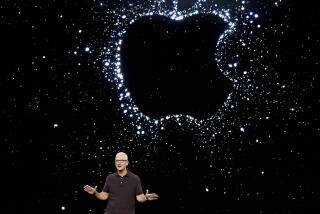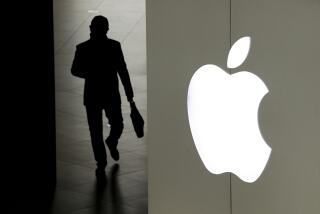Apple Wins 1st Round in Microsoft, H-P Suit
SAN FRANCISCO — A federal judge gave Apple Computer Inc. an important preliminary victory Friday in its legal battle with fellow computer giants Microsoft and Hewlett-Packard, clearing the way for a copyright suit over visual displays for Apple’s Macintosh system.
U.S. District Judge William Schwarzer issued a tentative ruling, which he affirmed by comments at an hour-long hearing, that a 1985 Apple-Microsoft licensing agreement did not entitle Microsoft to produce a display program called Windows 2.03, the target of the copyright suit.
“Windows 2.03, the product as it is now being offered, is not covered by the license,” Schwarzer said.
The ruling means that Microsoft cannot claim permission from Apple to market a program with visual displays similar to those in the Macintosh, Apple’s biggest-selling model. But the case is far from over.
Apple still must prove that Windows 2.03 is “substantially similar” to the Macintosh menu screen graphics, distinctive for their use of pictorial symbols such as file drawers and wastebaskets, rather than written commands, to enter and use the computer system.
Microsoft and Hewlett-Packard, which uses the Windows display for a computer program called New Wave, contend that Apple’s own program was not original but was derived from other companies’ works.
They also argue that the graphics Apple is trying to protect are no more than basic ideas, like the use of office equipment as symbols. Ideas cannot be copyrighted, only expressions of ideas; courts have also refused copyright protection when an idea can be expressed in only one way.
The suit could have a large impact. Microsoft’s program is compatible with International Business Machines Corp. equipment; a verdict that gave broad protections to Apple’s “user-friendly” displays would keep similar systems off IBM computers and could slow the development of software for systems like Windows and New Wave.
Friday’s ruling knocked out Microsoft’s first line of defense against the suit: that the 1985 licensing agreement with Apple, allowing an early version of the display program called Windows 1.0, was broad enough to cover a later version such as Windows 2.03.
Schwarzer said his ruling was narrow and did not necessarily mean that any particular visual symbols, called “icons,” could not be duplicated. But the judge indicated disagreement with a suggestion by Microsoft lawyer David McDonald that the copyright claim could be decided by comparing each individual symbol in the two programs.






